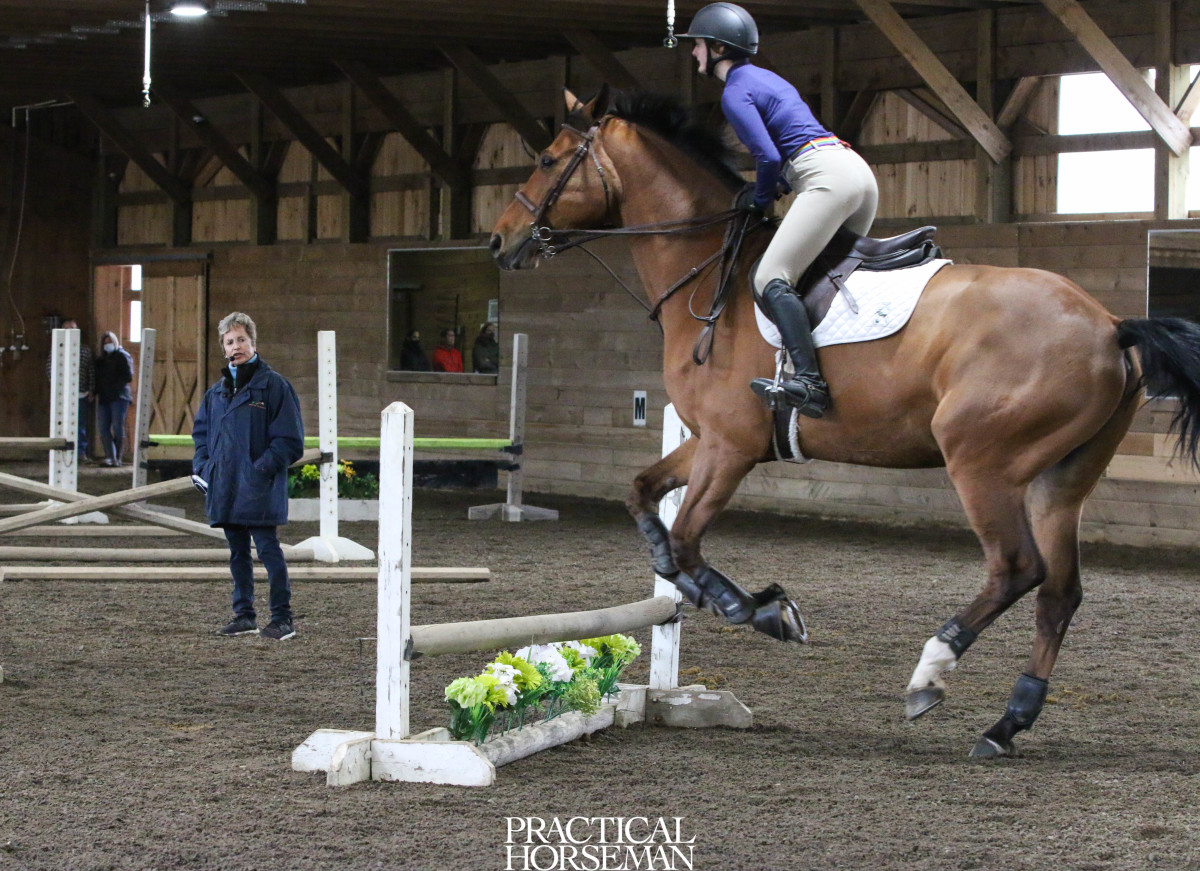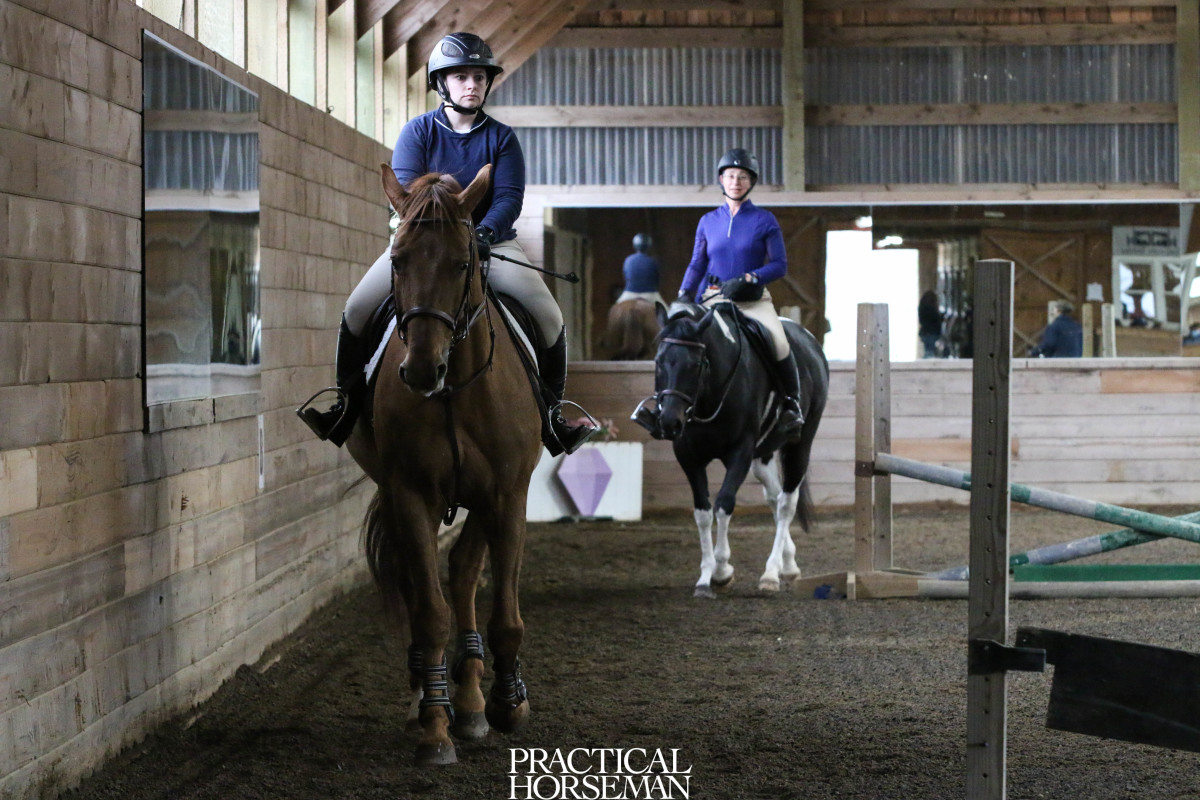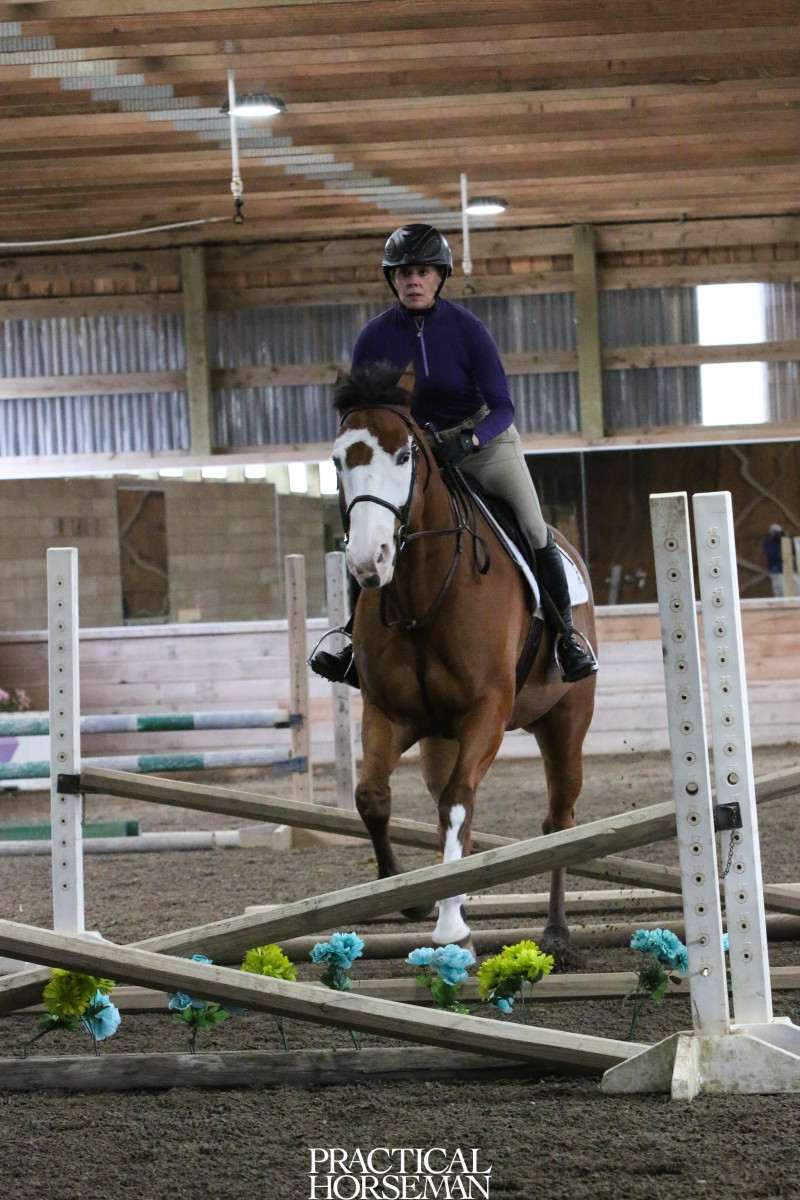When dressage rider Terry Golson moved to Maine in 2019, she decided to board her APHA registered Paint, Tonkas Midnight Snow, at hunter/jumper barn Greystone Stables in Berwick, Maine, because of its big stalls and nice turnout. She’d been a little hesitant because the barn was home to a lot of teenage girls and she had heard that subset could be challenging.
Instead, Golson found a group of young adults who not only welcomed her but also cheered her on, especially when she and Tonka started taking lessons over poles on the ground and then crossrails. As a way to thank them, Golson entered Practical Horseman’s “Win A Day with Margie Engle” contest more than a year ago. For the contest, Margie would travel to the winner’s stable and teach her and 10 friends.
Golson’s dream became reality Saturday, when Engle, an Olympian and World Equestrian Games team silver medalist who has won more than 200 grand prix classes, traveled from her home base in Wellington, Florida, to Jason Ludwick’s Greystone to teach Golson and 10 riders at the barn, many of whom were the same young riders who gave Golson so much support.

“Winning this was really a gift to the people at the barn who welcomed me here and brought me into their world of their little hunter/jumper shows and the jumping, and the kids are great,” Golson said after the clinic, which was sponsored in partnership with Equimax, a dewormer made by Bimeda. Golson had won the contest out of nearly 550 entrants who all had written short essays on why they should win. The top 10 finalists made five-minute videos further pitching their case.
“This was the way for them to have a very special day,” Golson said. “Margie was amazing, of course, because Margie’s eye is superb and laser focused, and she seemed to know exactly the exercises that we needed to learn and what we need to do to progress.”
The young women at the stable agreed. “Having the opportunity to ride with Margie was such an incredible once-in a lifetime opportunity,” said 15-year-old Katie Plaisted, who rode in the fourth and final session of the day. “She is such a great teacher as well as rider, and I learned so much even just from watching the others in the clinic.”

“It was an amazing experience, and we couldn’t be happier with how things turned out,” enthused Lilly Leonard, 15, who rode in the session with Plaisted.
‘You Can Never Use Enough Leg’
The morning of the clinic, the stable hummed with activity in anticipation of Engle’s arrival. Golson was busy rubbing out the manure stain her black-and-white Tonka had acquired on the white part of his hind leg. Plaisted took out one of the ponies to longe him briefly before his session with Engle with another rider. Ten-year-old Ryen McDaniel, along with many of the other clinic riders and resident trainers Stephanie Plaisted (Katie’s mother) and Kate McDaniel, helped bring in poles to set the course in the indoor arena for the lessons.
Rain during the week had required the clinic be in the indoor ring, which had been watered and dragged with the arena mirrors squeegeed the night before; new plastic flowers decorated the jumps. The clinic was divided into four sessions, with jumping levels ranging from 18 inches to 3 feet. One of the four sessions was two Short Stirrup riders on their ponies. Engle arrived shortly before 9 a.m. and the lessons began.
Despite the differences in skill levels and fence heights, Engle structured the lessons similarly: flatwork with a focus on transitions; riding two poles on the ground in five, six and four strides; and riding a small course that included a one-stride trot gymnastic and a bounce.
A main training theme emerged with all of the sessions: Use your leg to ride forward to engage the horse’s hind end and maintain that with a light connection with the hand. As Engle said to Lily Baker who rode Champ in the first session, “You can never use enough leg, even with a sensitive horse.”
Ride Forward on the Flat
Engle started with Golson and Baker’s session, asking them to ride their horses forward off their legs. Soon after, she had them lengthen their horses’ strides down the long side of the arena in posting trot and shorten and collect on the short side in sitting trot.

When the riders collected, Engle instructed them to use their legs and seats to drive the horses forward yet keep a connection with the hand. “You want a lively trot with more impulsion behind,” Engle said to Baker. “You want him to feel light in hand. You want him to feel like he’s carrying himself not you carrying him.”
After the trot work, Engle had the riders canter, but they needed to make sure their horses were engaged from behind and balanced at the trot before they asked. When Golson’s Tonka had a new spring in the posting trot, Engle asked Golson to ride a transition to sitting trot, reminding her to use her leg and seat before her hand. “Establish a nice balanced sitting trot that’s very active behind. Then sit deep and drive him forward” into the canter, Engle said.
Even though most of the riders rode in hunter or equitation divisions where they are often encouraged to stay in two-point at the canter, Engle had them remain in full seats. After Golson lengthened down the long side, Engle had her work on more engagement by riding a circle at one end of the arena. “Go down the long side, then ride a small circle to the left, using your leg and seat to collect him,” Engle instructed, having Golson bend him around her inside leg as well. When Tonka looked more uphill and lighter, Engle added, “There he started to engage behind.”
Two Poles on the Ground
After the horses were more engaged on the flatwork, Engle had the riders canter two poles on the ground across the diagonal. The poles were set so they could be ridden in a nice five strides, and then Engle had the riders collect and ride the exercise in six strides and four strides.
In the third group, Monika Calitri’s Finnigan rode the five strides easily but was more challenged fitting in the six strides because Finnigan didn’t change his stride length easily. When he raised his head or broke to the trot as Calitri tried to collect him, Engle told her to use more leg to “coil” his stride. Once they succeeded in getting the six strides, Engle said, “See you can do it, but it’s a lot of work.” To ride the line in four strides, Engle told Calitri that she needed to go forward through the turn with a little feel of his mouth, and once over the first pole gallop to get the four strides. “You’re putting your leg on and he’s going at the same pace,” Engle said. “Be more assertive when you land [from the first pole.] Keep kicking.”

Gymnastics and a Course
After the pole exercise, Margie had the riders jump a small course, starting with a gymnastic with a trot pole to a crossrail, then one stride to a second crossrail or vertical, depending on the rider’s experience. Between the one stride was another placing pole. So the riders trotted over the first placing pole, over the crossrail, over they placing pole, then finishing over the second crossrail/vertical.
After the gymnastic, Margie had the riders make a tight left turn to an outside six-stride line, to another left turn to a bounce set across the diagonal, to an outside five-stride line. The more experienced riders then finished over a long approach to an oxer set on a diagonal.
As Katie Plaisted approached the gymnastic on Counterno Boy, Engle told her to focus on her position and keeping her horse straight. “It’s a good exercise because you don’t have to worry about distance,” she said. To all the riders, she reminded them that “you need to make sure he’s in front of your leg, even if you’re just trotting.”
Amanda Conley’s Due Diligence sometimes had trouble maintaining rhythm around the course. Margie said it looked like Conley worried about him getting strong and take on his mouth, causing him to go up and down. Instead, she told Conley to let him go. “You relaxed your hand to the last oxer, and he leveled out,” Engle said. Though she wanted Conley to relax her hand, she also wanted her to maintain a light connection with the hand, not throw it away.

Engle also advised Conley not to be so worried about finding the perfect distance. “I’d like to see you guys take a deep breath and let it happen. Enjoy the process a little more,” Engle told her as she rode around the course. “Just be patient. Be comfortable whether the distance is short or long. It’s not going to be perfect.”
After her session, Plaisted said, “The most important thing that I learned was that I need to ride more assertively and not let my horse take over and get his way.” I learned that there is a way to ride assertive and strong while also making it look like smooth and effortless.”
At the end of the day, after Engle said her goodbyes and headed to the airport, the riders bubbled over about the day. Golson was thrilled she had delivered a gift to give back to the riders who had been so supportive to her.
“We’re way up here in Maine,” Golson said. “People don’t come up here, so for Margie to come here and tell the kids they’re valued and that they have talent and that they can do this too, even when you’re in a little out-of-the-way town—that’s a really big deal.”
Thanks to Equimax for its sponsorship of the Win A Day with Margie Engle clinic.












